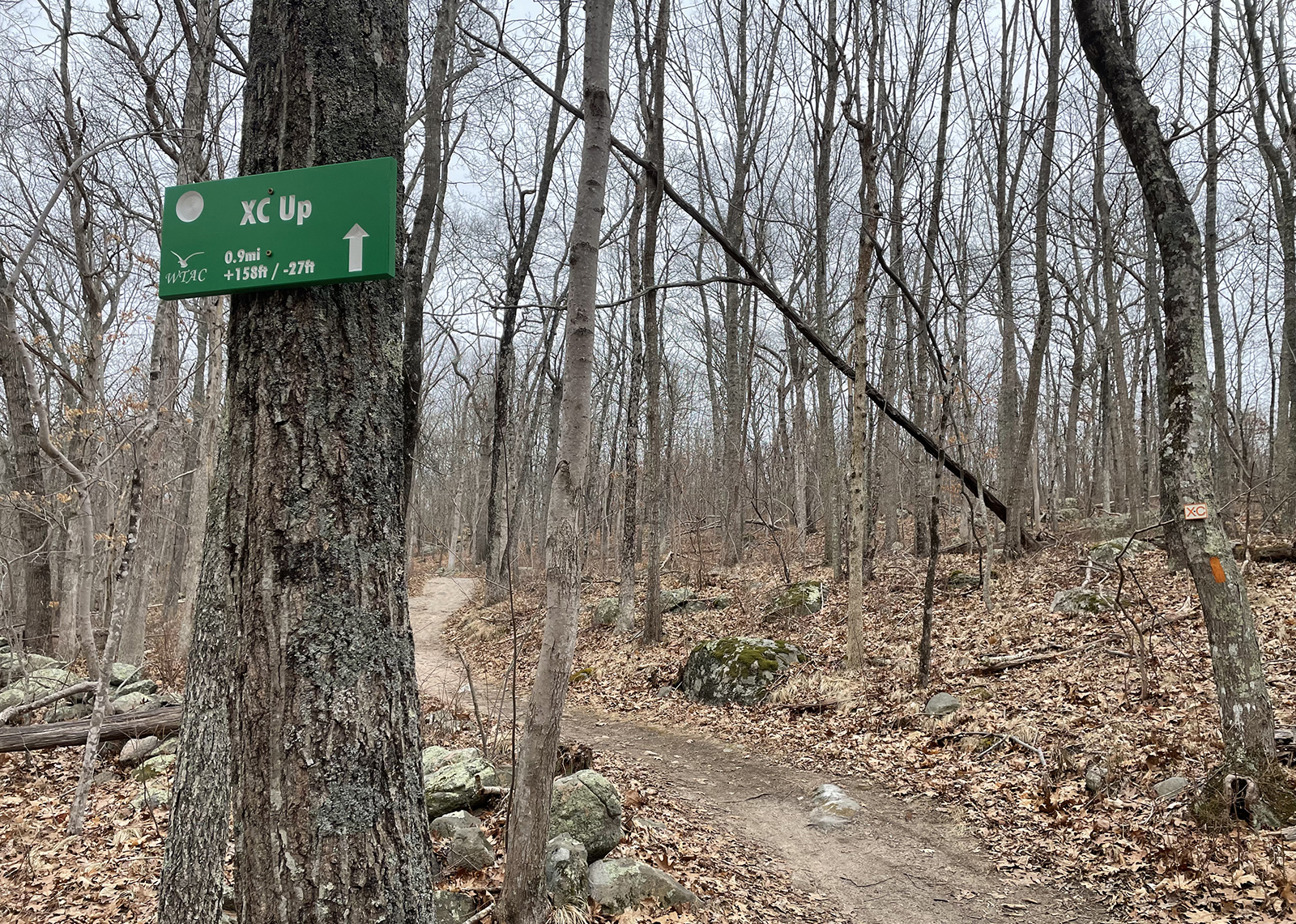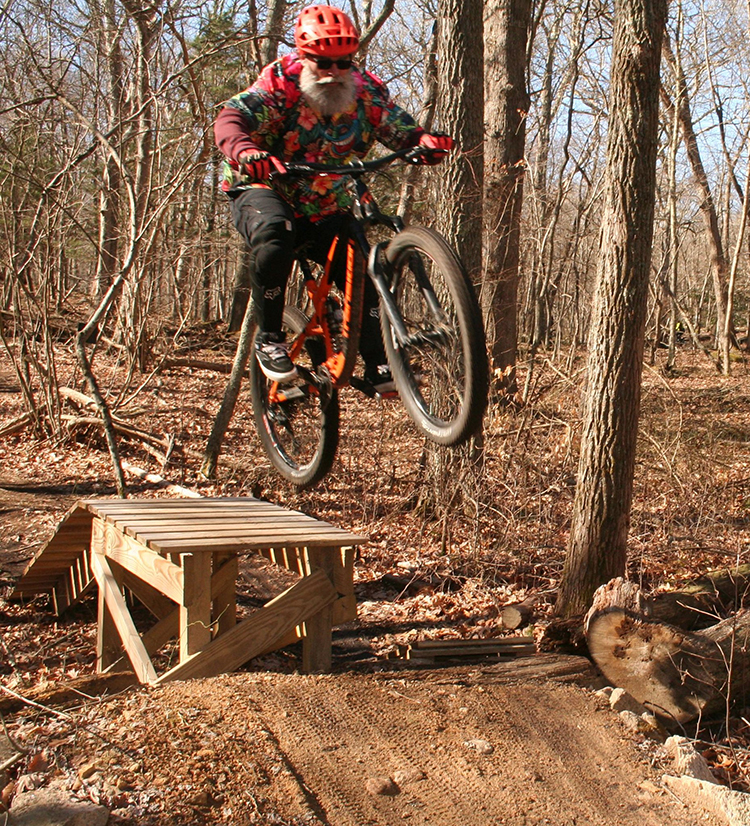Finding Delicate Balance On Management Area Trails Tricky
March 27, 2023
WESTERLY, R.I. — The first site that pops up in an internet search for Woody Hill is “Woody Hill Management Area Wildlife Park.” But the network of wooded trails off Route 91 in Bradford is bustling with human activity, including riding the trails in the woods, which have become one of the state’s most popular venues for mountain biking.
It is that pressure from human activity that worries local resident and retired raptor rehabilitator John Maxson. A lifelong outdoorsman, Maxson credits the New England Mountain Bike Association (NEMBA) with getting more people to enjoy the outdoors, but he also worries about the impact of the additional traffic on the land and its nonhuman inhabitants.
“They do a nice job,” he said. “They’re very well organized, and I know they mean well. They’re getting these people out there in nature and I applaud that. It’s just that there’s a tradeoff here. Where does wildlife go when there’s so much noise and trails?”
The trails and fields are also used for high school sports, including cross country and lacrosse. James Federico, chair of the Westerly Municipal Land Trust, said coordinating the many activities is a collaborative effort.
Balancing the needs of several organizations who share the property, including Westerly Area Youth Lacrosse, the Rhode Island Chapter of the New England Mountain Bike Association, the Westerly Track and Athletic Club, and the Westerly High School and Middle School cross country teams, requires “bringing the stakeholders together to discuss event feasibility,” Federico said.

The different sections of the Woody Hill Management Area are owned and managed by three separate entities: two land trusts and the Rhode Island Department of Environmental Management.
The state owns 723 acres, the Westerly Land Trust owns 85 acres, and the Westerly Municipal Land Trust owns the remaining 249 acres. Federico explained the ownership of the property.
“The RIDEM (State of Rhode Island) owns the Woody Hill Management Area,” he wrote in an email. “The Westerly Municipal Land Trust (Town of Westerly) owns the property that, for the most part, encircles the State owned Woody Hill Management Area (formally known as the Lucey properties). The Westerly Land Trust [Private] owns a few parcels nestled in between the aforementioned property owners, predominantly on the southern edge of the expanse.”
He noted the three organizations are responsible for managing their own properties and communicate with each other “periodically.” He said the Westerly Municipal Land Trust relies heavily on cooperation from property users where maintenance — e.g., trail condition and trimming of overgrowth — and sanitation are concerned.
Marc Doherty, land stewardship manager for the Westerly Land Trust, noted most of the trails are on Westerly Municipal Land Trust (WMLT) property.
“We manage Wahaneeta Preserve, which was a former Girl Scout camp, and it’s just under 85 acres on the southwest side of the entire Woody Hill area,” he said. “The rest of the area is a conservation area managed by the state as part of the Woody Hill State Management Area, and the town also manages some conservation property there. I believe they call it the Bradford Preserve.”
Motorized vehicles, such as dirt bikes, are prohibited on the Woody Hill trails. In 2017, however, in response to a request from NEMBA’s Rhode Island chapter, the municipal land trust agreed to open the trails to mountain bikes.
“We felt NEMBA was a good fit for the property and have a great reputation in the area [Burlingame] and beyond,” Federico wrote. “We thought it made perfect sense to grow the activity on WMLT property, especially because of its proximity to the Burlingame trails and the opportunity to create one of, if not the largest contiguous network of mountain biking trails in the State. The Bradford trails offer all levels of mountain biking, for beginners or expert, from flat to extremely technical in nature. RINEMBA has been wildly successful in the area, with thousands of riders using the property annually.”
Paul Kintz, NEMBA’s Woody Hill ride representative, said volunteers from the group’s Rhode Island chapter build and maintain the property’s trail network.
“When you’re talking about trail building, you have to design the trail network that’s good for the users that go in there and then you have to design the overall layout of the trail network and then, you have to actually cut it,” he said. “And then, in terms of maintenance, you’re going to find that there’s a lot of trees that fall down in the woods.”

DEM spokesperson Michael Healey said NEMBA’s trail building and maintenance have made it possible for more people to enjoy the state’s wildlife management areas (WMAs).
“The use and maintenance of our trail systems is an important way for the public to enjoy natural spaces,” he said. “Stewardship of trails offers a powerful avenue for encouraging volunteerism, partnership, and stewardship in our parks and WMAs. People love to volunteer on trail maintenance, and trail management can greatly benefit from volunteers. User groups can help create, maintain, restore, or close trails. Groups can raise money and advocate for funding. Individuals and organizations can adopt trails. For volunteerism to be effective, it must be guided, directed, and managed. DEM appreciates our partnerships with NEMBA and other like-minded nongovernmental organizations. We also rely on our partners heavily in our role as stewards of state WMAs.”
Trail building has evolved in recent years to be more sustainable, and Kintz said he and another NEMBA member attended a trail-building school in New Hampshire.
“The whole purpose of that is to learn how to build sustainable trails, and these are multipurpose trails, so, walkers, bikers, doesn’t matter,” he said. “It’s a general concept that applies for anything. … There’s actually going to be one hosted at Woody Hill this year.”
Sustainable trail-building techniques, practiced by organizations such as the Appalachian Mountain Club, include choosing trail locations and routes to minimize erosion.
“A lot of the challenge is managing the slope and managing the drainage,” Kintz said. “A couple of the major concepts are, you don’t want the trail to be too steep over a sustained period and you need to provide ways so that the water doesn’t build up on the trail.”
NEMBA volunteers have also created features to make the trails more interesting in the Woody Hill trail network, which, counting state-owned land and the Wahaneeta Preserve, comprises between 35 and 40 miles.
“In some places, there are wooden jumps that are built or small drops, and then there’s also a number of rock features,” Kintz said. “I tend to do a lot of rock work and I can use that as erosion prevention in some areas. There’s one particular area where there was a steep incline and rather than rerouting it and closing it, I ended up paving over the section with rocks so you can either ride up it or ride down it, and it’s very suitable for walking as well.”
Healey said NEMBA also holds a state license to hold six larger “fun ride” events each year.
“DEM and the New England Mountain Bike Association have a license agreement that allows NEMBA to hold six rides at various DEM-managed properties a year, including one at Woody Hill,” Healey said. “This year’s event will be held July 9 with a rain date July 16. As with all state license agreements, this agreement requires NEMBA to clean up and return the property to its prior condition. All license agreements — whether this one with NEMBA, the Newport musical festivals, or The Ocean Race — must be vetted and approved by the State Properties Committee.”
Finding ways for hikers and mountain bikers to coexist on the trails is a challenge environmental and wilderness preservation groups have been grappling with for years.
Aaron Teasdale wrote, in the Sierra Club magazine in 2017, that it was important to recognize that mountain bikers also had a right to enjoy the backcountry.
“Let me be 100 percent clear: Bikes should not be allowed in federal wilderness areas,” he wrote. “There is no spot in the Lower 48 that is more than 22 miles from a road, and wilderness areas are one of the few places left for people on foot to find peace and escape modernity’s din. But mountain bikers have a place in the backcountry as well. We conservationists need more, not fewer, allies in our efforts to protect wild places — and that will require hikers, backpackers, and other outdoor enthusiasts to make a fresh attempt to understand where bikers are coming from and what they want, too.”
Kintz said his group is aware of the potential for user conflicts in Woody Hill and on other trails.
“You have hunters, you have walkers, you have mountain bikers, you have equestrians who are out there,” he said. “So, learning how to deal with each of those groups is really important, and we do put a focus on helping to teach mountain bikers to do that. For instance, we’ve got a beginner skills clinic that we hosted last year, and we’ve got another one that we’re hosting at the end of April this year.”
Doherty noted his organization considers wildlife habitat as part of its management strategy.
“We realize it’s an overall benefit to get people outside and active and that’s something that we want to promote, but there are also certain habitats and certain plants and animals that we want to protect and they can be directly, negatively influenced by human traffic, so when we build our trails, we try to take it all into consideration,” he said.
Maxson said he hoped that all the human activity in the woods could somehow leave wildlife some space.
“I’m totally in favor of them being in there,” he said. “They just need to be aware of what they’re doing.”




RINEMBA will be hosting a trail building clinic at Woody Hill this year that will be open to all NEMBA chapters. It’s purpose is to promote environmentally sustainable trail building and use. This is the first trail building clinic that Nemba has hosted that includes not only members, but is also paying the registration fee for land managers and DEM to attend. A pretty awesome communication event.
It’s funny that most of the trails out there and in other wilderness in town were made by “motorized” vehicles many years ago when mountain biking wasn’t. But now they are just left out of the equation here and the rest of RI!
Great article, but it still doesn’t answer the questions: “Where does wildlife go when there’s so much noise and trails?”